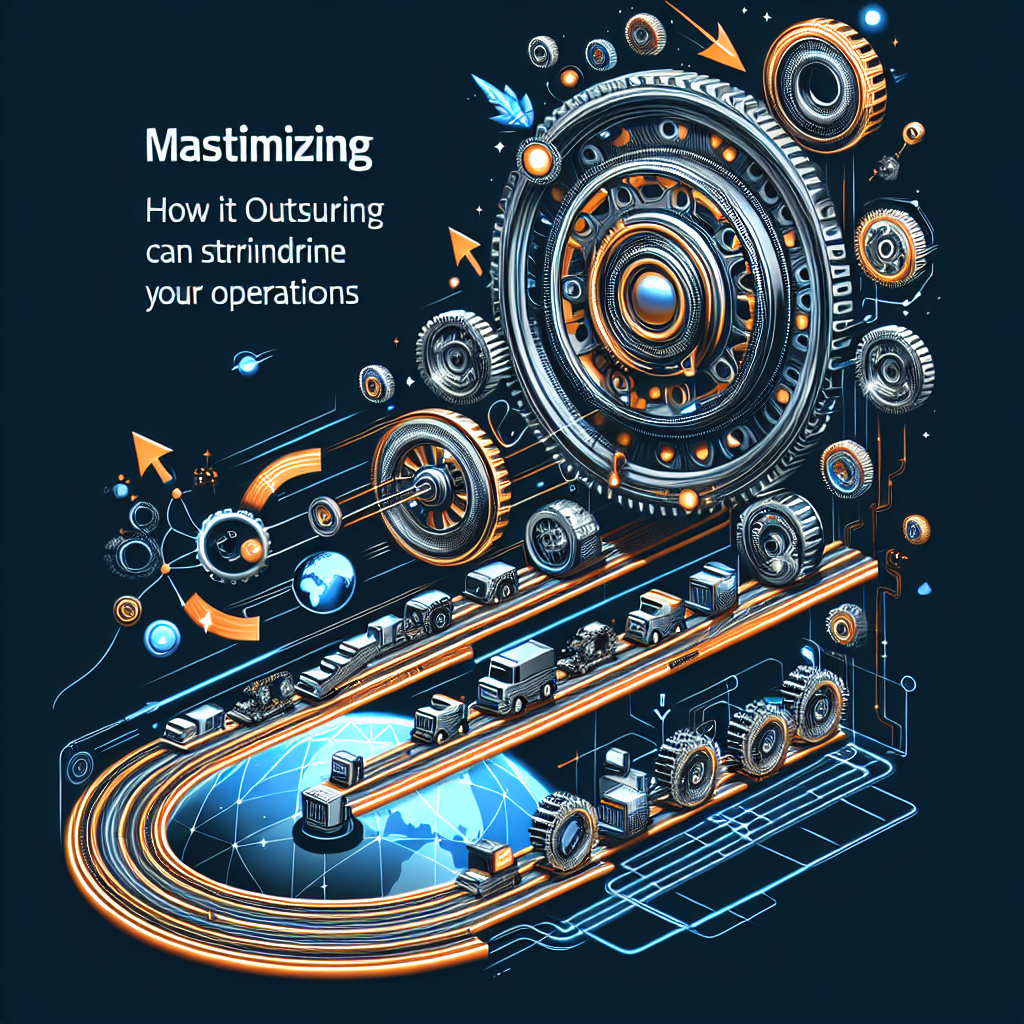Your cart is currently empty!
Tag: IT Outsourcing

Avoiding Common Pitfalls: How to Ensure a Smooth IT Outsourcing Transition
Outsourcing IT services has become a popular option for businesses looking to cut costs and improve efficiency. However, transitioning to an outsourced IT model can be challenging, and there are several common pitfalls that businesses should avoid to ensure a smooth transition.One of the most common pitfalls in IT outsourcing is failing to clearly define goals and expectations. Before outsourcing any IT services, it is important for businesses to have a clear understanding of what they hope to achieve through outsourcing, as well as the specific services they require. Without a clear vision, businesses may end up with a provider that does not meet their needs or delivers subpar results.
Another common pitfall is choosing the wrong outsourcing provider. It is essential for businesses to conduct thorough research and due diligence when selecting an outsourcing partner. This includes checking references, reviewing case studies, and assessing the provider’s track record in delivering similar services. Failing to choose the right provider can result in delays, cost overruns, and poor quality of service.
Communication is also key to a successful IT outsourcing transition. Businesses must maintain open lines of communication with their outsourcing provider throughout the transition process. This includes clearly communicating goals and expectations, providing regular feedback, and addressing any issues or concerns as they arise. Without effective communication, misunderstandings can occur, leading to delays and conflicts.
Another pitfall to avoid is failing to plan for the long term. IT outsourcing is not a one-time solution, but rather an ongoing partnership. Businesses must have a clear plan for how they will manage and monitor their outsourcing provider over the long term, including regular performance reviews and contract renewals. Failing to plan for the long term can result in ineffective outsourcing arrangements and missed opportunities for improvement.
Finally, businesses must avoid the pitfall of underestimating the importance of internal change management. Transitioning to an outsourced IT model can have a significant impact on employees and internal processes. It is essential for businesses to involve employees in the transition process, provide training and support as needed, and ensure that internal systems and processes are aligned with the outsourced services. Failing to manage internal change effectively can result in resistance, confusion, and decreased productivity.
In conclusion, transitioning to an outsourced IT model can offer many benefits for businesses, but it is important to avoid common pitfalls to ensure a smooth transition. By clearly defining goals and expectations, choosing the right provider, maintaining open communication, planning for the long term, and managing internal change effectively, businesses can maximize the benefits of IT outsourcing and achieve success in their transition.

Cost Savings and Beyond: The Benefits of IT Outsourcing for Businesses
In today’s fast-paced and competitive business environment, companies are constantly looking for ways to cut costs and increase efficiency. One popular solution that many businesses are turning to is IT outsourcing. By outsourcing their IT functions to third-party service providers, companies can not only save money but also benefit from a wide range of other advantages.One of the most obvious benefits of IT outsourcing is cost savings. By outsourcing their IT services, companies can eliminate the need to hire and train in-house IT staff, which can be expensive and time-consuming. Outsourcing also allows businesses to access a team of skilled professionals at a fraction of the cost of hiring full-time employees. Additionally, outsourcing IT services can help companies reduce operational costs, such as hardware and software expenses, as well as overhead costs like office space and utilities.
But cost savings are just the tip of the iceberg when it comes to the benefits of IT outsourcing. Outsourcing IT services can also help businesses improve their overall efficiency and productivity. By entrusting their IT functions to experienced professionals, companies can focus on their core business activities and strategic goals, rather than getting bogged down in technical details. This can lead to increased productivity, faster decision-making, and ultimately, improved business performance.
Furthermore, outsourcing IT services can also help businesses stay ahead of the curve when it comes to technology. IT outsourcing providers are constantly updating their skills and knowledge to stay abreast of the latest technological developments. By outsourcing their IT functions, companies can leverage the expertise of these professionals to implement cutting-edge technologies and solutions that can give them a competitive edge in the market.
Another benefit of IT outsourcing is enhanced security and risk management. IT outsourcing providers are well-versed in the latest cybersecurity threats and best practices for protecting sensitive data. By outsourcing their IT functions, companies can rest assured that their systems and data are being managed and monitored by experts who are dedicated to keeping them safe from cyberattacks and other security risks.
In conclusion, IT outsourcing offers a wide range of benefits for businesses beyond just cost savings. From increased efficiency and productivity to access to the latest technologies and enhanced security, outsourcing IT services can help companies streamline their operations, reduce risks, and stay ahead of the competition. For businesses looking to cut costs and improve their overall performance, IT outsourcing is definitely worth considering.

Maximizing Efficiency: How IT Outsourcing Can Streamline Your Operations
In today’s fast-paced business environment, maximizing efficiency is crucial for staying competitive and meeting customer demands. One way to achieve this is through IT outsourcing, which can streamline your operations and improve overall productivity.IT outsourcing involves hiring external IT service providers to handle certain aspects of your business’s technology needs. This can include managing software development, network maintenance, cybersecurity, and more. By outsourcing these tasks, you can free up internal resources and focus on core business activities.
One of the key benefits of IT outsourcing is the ability to access specialized expertise. IT service providers often have a team of skilled professionals with years of experience in various technologies and industries. This means they can quickly and efficiently address any IT issues that arise, minimizing downtime and ensuring smooth operations.
Outsourcing IT services also allows your business to stay up-to-date with the latest technology trends. IT service providers are constantly monitoring the market for new developments and innovations, and can help you implement cutting-edge solutions that improve efficiency and drive growth.
Additionally, outsourcing IT services can help reduce costs. By hiring external providers, you can avoid the expenses associated with hiring and training internal IT staff, as well as investing in expensive hardware and software. This can result in significant cost savings for your business.
Furthermore, outsourcing IT services can improve scalability and flexibility. As your business grows, you can easily scale up or down your IT services to meet changing demands. This flexibility allows you to adapt quickly to market changes and stay ahead of the competition.
Overall, IT outsourcing can streamline your operations and maximize efficiency in several ways. By leveraging specialized expertise, staying current with technology trends, reducing costs, and improving scalability, outsourcing IT services can help your business achieve its goals and drive success in today’s competitive marketplace.

The Pros and Cons of IT Outsourcing: Is it the Right Choice for Your Business?
In today’s digital age, information technology (IT) plays a crucial role in the success of businesses. However, not all companies have the resources or expertise to handle their IT needs in-house. This is where IT outsourcing comes in. Outsourcing IT services to a third-party provider can offer numerous benefits, but it also comes with its own set of challenges. In this article, we will explore the pros and cons of IT outsourcing to help you determine if it is the right choice for your business.Pros of IT Outsourcing:
1. Cost Savings: One of the biggest advantages of IT outsourcing is cost savings. By outsourcing IT services, businesses can avoid the high costs associated with hiring and training in-house IT staff. Additionally, outsourcing allows companies to pay for only the services they need, making it a more cost-effective option for small and medium-sized businesses.
2. Access to Expertise: IT outsourcing gives businesses access to a team of skilled professionals with specialized expertise in various areas of IT. This can help improve the efficiency and effectiveness of IT operations, leading to better overall performance and productivity.
3. Focus on Core Business Activities: By outsourcing IT services, businesses can free up their internal resources to focus on core business activities. This can help improve business performance and drive growth, as employees can devote their time and energy to tasks that directly contribute to the company’s success.
4. Scalability: IT outsourcing allows businesses to easily scale their IT operations up or down based on their needs. This flexibility can be particularly beneficial for businesses that experience fluctuations in demand or seasonal changes in workload.
Cons of IT Outsourcing:
1. Loss of Control: One of the main drawbacks of IT outsourcing is the loss of control over IT operations. When outsourcing IT services, businesses rely on a third-party provider to manage their IT infrastructure, which can lead to potential issues with communication and decision-making.
2. Security Risks: Outsourcing IT services can pose security risks, as businesses may be exposing sensitive data to external parties. It is important for businesses to carefully vet their IT outsourcing provider and implement robust security measures to protect their data.
3. Quality Concerns: There is also a risk of quality concerns when outsourcing IT services. Businesses may encounter issues with service delivery, response times, and overall performance if they choose an unreliable or inexperienced IT outsourcing provider.
4. Hidden Costs: While IT outsourcing can lead to cost savings, businesses should be aware of potential hidden costs associated with outsourcing, such as setup fees, maintenance costs, and additional service charges. It is important for businesses to carefully review their outsourcing agreements to ensure they understand all costs involved.
In conclusion, IT outsourcing can offer numerous benefits for businesses, including cost savings, access to expertise, and scalability. However, it also comes with its own set of challenges, such as loss of control, security risks, quality concerns, and hidden costs. Ultimately, the decision to outsource IT services should be carefully considered based on the specific needs and goals of your business. By weighing the pros and cons of IT outsourcing, you can determine if it is the right choice for your business.

Key Considerations for Outsourcing IT Security Services
Outsourcing IT security services has become a popular choice for many businesses looking to enhance their cybersecurity posture. With the increasing number of cyber threats and attacks targeting organizations of all sizes, it has become imperative for companies to invest in robust security measures to protect their sensitive data and networks. However, outsourcing IT security services is not a decision that should be taken lightly. There are several key considerations that organizations need to keep in mind before selecting a third-party provider to handle their cybersecurity needs.One of the most important factors to consider when outsourcing IT security services is the reputation and experience of the service provider. It is essential to choose a company that has a proven track record of delivering high-quality security solutions and has experience working with businesses in your industry. A reputable provider will have the necessary expertise and resources to effectively protect your organization from cyber threats and vulnerabilities.
Another essential consideration is the range of services offered by the IT security provider. Different organizations have different security needs, so it is crucial to select a provider that can offer a comprehensive suite of services tailored to your specific requirements. Some of the key services that a provider should offer include network security, endpoint security, threat intelligence, incident response, and security monitoring.
Cost is also a significant factor to consider when outsourcing IT security services. While it may be tempting to opt for the cheapest provider, it is essential to remember that quality should not be compromised for cost savings. It is crucial to conduct a thorough cost-benefit analysis to ensure that the provider offers value for money and can deliver the level of security that your organization requires.
Additionally, organizations should consider the level of customer support and responsiveness provided by the IT security provider. In the event of a security incident or breach, it is crucial to have a provider that can respond quickly and effectively to mitigate the impact and prevent further damage. A provider that offers 24/7 support and has a dedicated team of security experts available to assist in emergencies is highly desirable.
Lastly, organizations should also consider the compliance and regulatory requirements that apply to their industry. It is essential to select an IT security provider that has a thorough understanding of industry-specific regulations and can help ensure that your organization remains compliant with relevant laws and standards.
In conclusion, outsourcing IT security services can be a cost-effective and efficient way for organizations to enhance their cybersecurity defenses. However, it is crucial to carefully consider the reputation, services offered, cost, customer support, and compliance capabilities of potential providers before making a decision. By taking these key considerations into account, organizations can select a trusted and reliable partner to help protect their sensitive data and networks from cyber threats.

Case Studies: How Companies Have Successfully Implemented IT Outsourcing
IT outsourcing has become a popular strategy for companies looking to improve efficiency, reduce costs, and focus on their core business activities. By outsourcing their IT operations to third-party providers, companies can benefit from specialized expertise, access to the latest technologies, and round-the-clock support.Many companies have successfully implemented IT outsourcing to achieve their business goals. Let’s take a look at some case studies of companies that have effectively leveraged IT outsourcing to drive growth and innovation.
1. IBM: IBM is a global technology company that has been a pioneer in IT outsourcing for decades. By partnering with IT outsourcing providers, IBM has been able to focus on developing cutting-edge technologies and solutions for its clients. IBM’s strategic approach to IT outsourcing has enabled the company to streamline its operations, reduce costs, and improve customer satisfaction.
2. Procter & Gamble: Procter & Gamble, a multinational consumer goods company, has successfully implemented IT outsourcing to support its global operations. By outsourcing IT services such as application development, infrastructure management, and help desk support, Procter & Gamble has been able to improve its operational efficiency and drive innovation. The company has also benefited from access to specialized expertise and scalable resources, enabling it to adapt to changing market demands.
3. Netflix: Netflix, a leading streaming service provider, has leveraged IT outsourcing to support its rapid growth and expansion. By partnering with IT outsourcing providers, Netflix has been able to scale its IT infrastructure, enhance its data analytics capabilities, and improve its customer experience. The company’s strategic approach to IT outsourcing has enabled it to stay ahead of the competition and deliver high-quality content to its subscribers.
4. General Electric: General Electric, a multinational conglomerate, has successfully implemented IT outsourcing to drive digital transformation and innovation. By outsourcing IT services such as cloud computing, cybersecurity, and data analytics, General Electric has been able to accelerate its digital initiatives and improve its operational efficiency. The company’s strategic approach to IT outsourcing has enabled it to stay competitive in the rapidly evolving technology landscape.
In conclusion, these case studies demonstrate how companies have successfully implemented IT outsourcing to achieve their business objectives. By partnering with the right IT outsourcing providers and adopting a strategic approach, companies can drive growth, innovation, and efficiency. IT outsourcing has become a key enabler for companies looking to stay competitive in today’s digital economy.

Choosing the Right IT Outsourcing Model for Your Business
In today’s fast-paced business environment, many companies are turning to IT outsourcing as a way to reduce costs, increase efficiency, and gain access to specialized expertise. However, choosing the right IT outsourcing model for your business can be a daunting task. There are several different outsourcing models to choose from, each with its own advantages and disadvantages. In this article, we will discuss some key factors to consider when selecting the right IT outsourcing model for your business.The first step in choosing the right IT outsourcing model is to assess your business needs and objectives. Are you looking to outsource a specific project or function, such as software development or technical support? Or are you looking for a more comprehensive IT outsourcing solution that includes a range of services, such as infrastructure management, network security, and data analytics? By clearly defining your goals and requirements, you can narrow down your options and focus on finding the outsourcing model that best aligns with your business needs.
Another important factor to consider when choosing an IT outsourcing model is the level of control and flexibility you require. Some outsourcing models, such as staff augmentation or dedicated team, provide a high level of control over the outsourced resources and allow you to closely manage the project and team members. Other models, such as managed services or cloud computing, offer a more hands-off approach, allowing the outsourcing provider to take on more responsibility for managing and delivering IT services. Depending on your business requirements and preferences, you may prefer a more collaborative or a more hands-off outsourcing model.
Cost is also a key consideration when choosing an IT outsourcing model. While outsourcing can help reduce costs by eliminating the need to hire and train in-house IT staff, it is important to carefully evaluate the total cost of ownership of each outsourcing model. Some models may have lower upfront costs but higher long-term expenses, while others may require a larger initial investment but offer greater cost savings over time. By comparing the costs and benefits of different outsourcing models, you can choose the one that offers the best value for your business.
Finally, it is important to consider the reputation and track record of the outsourcing provider when selecting an IT outsourcing model. Look for a provider with a proven track record of delivering high-quality IT services and meeting client expectations. Check references, read customer reviews, and ask for case studies or testimonials to assess the provider’s reputation and reliability. A reputable outsourcing provider will not only deliver the services you need but also add value to your business by providing expertise, innovation, and strategic guidance.
In conclusion, choosing the right IT outsourcing model for your business requires careful consideration of your business needs, objectives, control preferences, costs, and the reputation of the outsourcing provider. By taking the time to evaluate your options and select the outsourcing model that best fits your requirements, you can ensure a successful IT outsourcing partnership that delivers value and helps drive your business forward.

IT Outsourcing Trends: What to Expect in 2021 and Beyond
In recent years, IT outsourcing has become a popular choice for businesses looking to reduce costs, increase efficiency, and access specialized skills. As we look ahead to 2021 and beyond, there are several key trends in the IT outsourcing industry that are expected to shape the way companies approach outsourcing their IT needs.One of the biggest trends in IT outsourcing is the continued growth of cloud computing services. As more businesses move their operations to the cloud, there is an increasing demand for IT outsourcing providers who can help companies manage and optimize their cloud-based infrastructure. This trend is expected to continue in 2021 and beyond, as businesses look for ways to leverage the scalability, flexibility, and cost-effectiveness of cloud computing.
Another important trend in IT outsourcing is the increasing focus on cybersecurity. With the rise of cyber threats and data breaches, businesses are placing a greater emphasis on securing their IT systems and data. As a result, IT outsourcing providers are expected to offer more robust cybersecurity services, such as threat detection, incident response, and security monitoring, to help businesses protect their sensitive information.
Additionally, as more businesses embrace digital transformation and adopt new technologies such as artificial intelligence, machine learning, and the Internet of Things, there is a growing need for IT outsourcing providers who can help companies integrate these technologies into their operations. In 2021 and beyond, we can expect to see an increase in demand for IT outsourcing services that specialize in these emerging technologies.
Furthermore, the COVID-19 pandemic has accelerated the adoption of remote work and virtual collaboration tools, leading to a greater reliance on IT outsourcing providers to support remote teams and ensure business continuity. In the coming years, businesses will continue to seek out IT outsourcing partners who can help them navigate the challenges of remote work and enable seamless collaboration among distributed teams.
Overall, the IT outsourcing industry is expected to continue to evolve and adapt to the changing needs of businesses in 2021 and beyond. As companies look to optimize their IT operations, reduce costs, and stay ahead of the competition, outsourcing IT services will remain a crucial strategy for achieving these goals. By staying abreast of the latest trends in IT outsourcing, businesses can position themselves for success in the digital age.

Navigating the World of IT Outsourcing: Tips for Finding the Right Partner
Outsourcing IT services has become a popular trend in today’s business world. Many companies are turning to outsourcing to reduce costs, improve efficiency, and access specialized skills and expertise. However, finding the right IT outsourcing partner can be a daunting task. With so many options available, it can be overwhelming to navigate the world of IT outsourcing. Here are some tips to help you find the right partner for your business:1. Define Your Needs: Before you start looking for an IT outsourcing partner, it’s important to clearly define your needs and objectives. What specific IT services do you need? Are you looking for a partner to manage your entire IT infrastructure, or do you need help with a specific project or task? By outlining your requirements, you can narrow down your search and find a partner that meets your needs.
2. Research Potential Partners: Once you have defined your needs, start researching potential IT outsourcing partners. Look for companies with a proven track record of delivering quality services and meeting client expectations. Check their credentials, read client testimonials, and ask for references. It’s also important to consider the size and scope of the outsourcing company – a smaller company may offer more personalized service, while a larger company may have more resources and expertise.
3. Evaluate Communication and Transparency: Effective communication is key to a successful outsourcing partnership. Make sure the outsourcing company you choose is responsive, transparent, and proactive in their communication. They should keep you informed about project progress, address any concerns or issues promptly, and be willing to collaborate with your internal team.
4. Consider Cultural Fit: When outsourcing IT services, it’s important to consider cultural fit. Look for a partner that shares your values, work ethic, and communication style. A good cultural fit can help foster a strong working relationship and ensure smooth collaboration between your internal team and the outsourcing partner.
5. Assess Security and Compliance: Data security and compliance are critical considerations when outsourcing IT services. Make sure the outsourcing partner has robust security measures in place to protect your sensitive information and comply with relevant regulations and standards. Ask about their data security protocols, certifications, and compliance practices to ensure your data is safe and secure.
6. Negotiate Clear Terms and Expectations: Before signing a contract with an IT outsourcing partner, make sure to negotiate clear terms and expectations. Define the scope of work, project timelines, deliverables, pricing, and any other important details in writing. This will help prevent misunderstandings and ensure both parties are on the same page throughout the outsourcing partnership.
Finding the right IT outsourcing partner can have a significant impact on your business success. By following these tips and doing thorough research, you can find a partner that meets your needs, aligns with your values, and helps you achieve your business goals. Outsourcing IT services can be a valuable investment for your business, so take the time to find the right partner for a successful and productive partnership.

